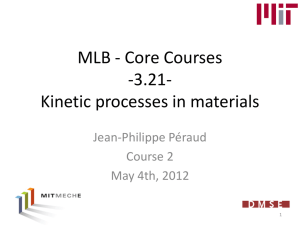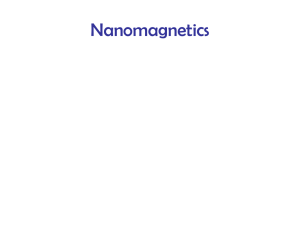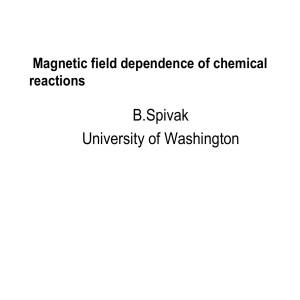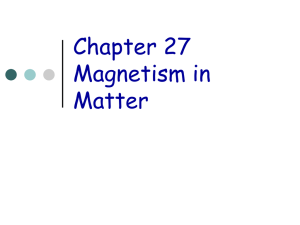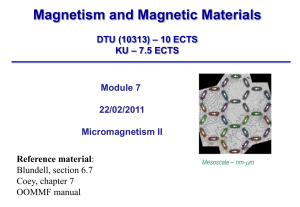Lecture 5 - Course Notes
advertisement
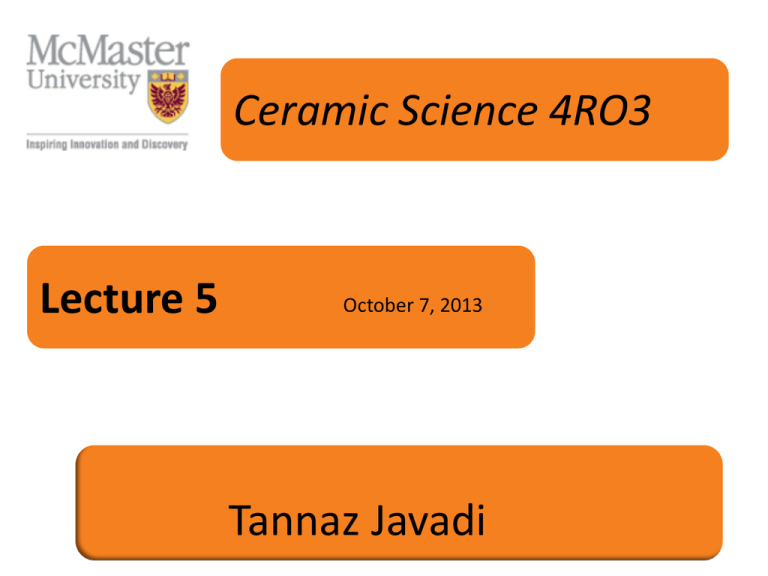
Ceramic Science 4RO3 Lecture 5 October 7, 2013 Tannaz Javadi Magnetic properties Susceptability (χ): similar to dielectric materials, is a parameter which expresses magnetic response of electron in a material to the applied magnetic field and is a dimensionless quantity. M: induced magnetization H: magnetic field Diamagnetic: • Materials with small negative susceptibility (χm < 0) • χm in Superconductors are -1 (Perfect Diamagnet). • Atoms have no net magnetic moments • Exposed to a field, a negative magnetization is produced (inherent effect) • The susceptibility is temperature independent o quartz (SiO2): -0.62x10-8 m3/kg, Calcite (CaCO3): -0.48x10-8 m3/kg, water: -0.90x10-8 m3/kg Materials with positive susceptibility are either paramagnetic, ferromagnetic or ferrismagnetic (χm > 1). Paramagnetism • Atoms have a permanent non-zero net magnetic moment due to the sum of orbital and spin magnetic moments. • The magnetic moments randomly orientated due to thermal fluctuations when there is no magnetic field. • The moments align parallel to the field when magnetic field is applied. • Susceptibility is positive but very small for paramagnetic materials o Montmorillonite (clay) 13x10-8 m3/kg Ferromagnetism • The magnetic moments in a ferromagnet aligned parallel to each other under the influence of a magnetic field. • These moments will then remain parallel when a magnetic field is not applied (unlike the moments in a paramagnet) • Above Tc, the Curie temperature, all ferromagnetic materials become paramagnetic. • Because thermal energy is large enough to overcome the cooperative The Curie temperature is an intrinsic ordering of the magnetic moments. property and is a diagnostic parameter that can be used for mineral identification saturation magnetization goes to zero Saturation Magnetization • The maximum induced magnetic moment that can be obtained in a magnetic field (Hsat); beyond this field no further increase in magnetization occurs. • An intrinsic property, independent of particle size but dependent on temperature. Ferromagnetic hysteresis loop • Domain that has a direction closest to that of the applied field grows at the expense of the other domains. • Such growth occurs by motion of the domain walls. • Initially domain wall motion is reversible, and if the applied field is removed the magnetisation will return to the initial demagnetised state. • In this region the magnetisation curve is reversible and therefore does not show hysteresis (OB) Ferromagnetic hysteresis loop (Point B): domains aligned in the direction of applied field and • saturation magnetization, MS(Point B), domains completely aligned (- MS in the opposite direction). Ferromagnetic Vs. Ferroelectric: • In ferromagnetic materials, favourably oriented domain growth at the expense of unfavourably oriented domains. • In ferroelectric materials, favourably oriented domains nucleate and grow. (Point C): the field is reduced to zero, • the domains do not come back to their configuration in the virgin state • a net magnetization in the absence of field called remnant magnetization, Mr ( -Mr in the opposite direction). (Point D): magnetization bring back to zero, • an extra field in the opposite direction is applied called coercive field, - Hc. (+Hc in the opposite direction). • hard magnet has large coercivity • soft magnet when coercivity is small. Antiferromagnetism • Without an applied field, adjacent magnetic moments (electron spins associated with magnetic atoms) align anti-parallel to each other. • Adjacent magnetic moments are equal in magnitude and opposite therefore there is no overall magnetisation. • This occurs below a particular temperature, called Néel temperature (TN) above which the material behaves as a paramagnet. • Ilmenite Ferrimagnetism • Antiparallel alignment of moments at particular atomic sites • Most of these materials consist of cations of two or more types (i.e. magnetic moment of one crystal sub-lattice is anti-parallel to the other) • The aligned magnetic moments are not of the same size. • An overall magnetisation is produced (net magnetization is not equal to zero) but not all the magnetic moments may give a positive contribution to the overall magnetisation. Example for Ferrimagnetic material • Magnetite (Fe3O4) • Spinel structure • The large oxygen ions are close packed in a cubic arrangement and the smaller Fe ions fill in the gaps. • The gaps come in two flavors, (two magnetic sublattices) tetrahedral site (A): Fe ion is surrounded by four oxygens octahedral site (B): Fe ion is surrounded by six oxygens • The spins on the A sublattice are antiparallel to those on the B sublattice A periodic table showing the elements and the types of magnetism at room temperature Diffusion • Migration of the defects which happens via an atomistic process called as diffusion. • Diffusion causes changes in the microstructures (sintering, creep deformation, grain growth) • Diffusion is also related to transport of defects or electronic charge carriers (electrical conductivity and mobility) Electrical conductivity •The electrical conductivity in ceramics is a sum of ionic and electronic conductivity o Ionic conductors applications: chemical and gas sensors, solid electrolytes fuel cell (optimization the fuel/air ratio in the engines by using an oxygen sensor made of ceramic ZrO2 in automobiles) Atomic diffusion rates & electrical conductivity Defect types Defect Concentration (T, PO2, Comp.) Diffusion Kinetics • Fick's First Law of Diffusion J: diffusion flux (moles/m2-s), and basically means the amount of material passing through a unit area per unit time; D: diffusion coefficient or diffusivity in m2/s; Diffusivity is a temperature dependent parameter x: the position in m. C: the concentration in m3 . Q: activation energy, D = D0 exp (-Q/kT) K: Boltzmann's constant D0: pre-exponential factor in m2/s. Diffusion Kinetics • Fick's Second Law of Diffusion o It predicts how the concentration changes as a function of time under non-steady state conditions t: is the time in seconds Driving force: the chemical potential which drives the migration of species from regions of higher chemical potential to lower chemical potential Temperature Dependence of Diffusivity In general, diffusivity can be expressed as γ: is governed by the possible number of jumps at an instant λ: is the jump distance and is governed by the atomic configuration and crystal structure. Schematic of the planes of atoms with arrows showing the cross-movement of species Γ: the jump frequency (# of atoms jump/ s) ν: the vibration frequency (s-1) ΔG*: the activation energy of migration (J) k: Boltzmann Constant (J/K). exponential temperature dependence resulting in significant increase in the diffusivity upon increasing the temperature Examples of Diffusion in Ceramics Diffusion in lightly doped NaCl (NaCl containing small amounts of CdCl2) CdCl2 → CdNa• + 2ClClx + VNa′ • In addition, NaCl will also have certain intrinsic sodium and chlorine vacancy concentration (VNa′ and VCl•) due to Schottky dissociation, depending on the temperature. ΔGNa* is the migration free energy for sodium vacancies [VNa‘] is the sodium vacancy concentration the diffusivity of sodium ions is governed by vacancy diffusion; Vacancy concentrations depends on dopant concentrations The diffusivity dependence on temperature shows two regimes Defect migration & Creation the vacancy concentration is governed by thermally intrinsic defect creation mechanism (Schottky defect formation) high temperature intrinsic diffusivity exhibits a steeper slope with higher activation energy which include not only the energy for defect migration but also for defect creation Defect migration Extrinsic region is dominant where vacancy concentration is constant as it is determined by the solution concentration i.e. [VNa'] = [CdNa•] . low temperature extrinsic regime where vacancy concentration is independent of temperature and is determined by solute concentration Mobility Diffusivity Conduction in ionic compounds Mobility: velocity (ν) of an entity per unit driving force (F); F can be defined as either of chemical potential gradient or electrical potential gradient. The most general driving force for atomic transport: the virtual force that acts on a diffusing atom or species and is due to negative gradient of the chemical potential or partial molar free energy. Where μi is the chemical potential of i and NA is the Avogadro's Number Relation between mobility and diffusion Absolute mobility, Bi is given by To obtain the relation between mobility and diffusivity of species, i, we need to write the flux in a general form as a product of concentration, ci, and velocity, vi, i.e. substituting for Fi for an ideal solution with unit activity of species i R is the gas constant. So, the change in the chemical potential can be written as Relation between mobility and diffusion compare the above equation with Fick's first law, diffusivity of species i can be written as The above equation is called Nernst Einstein Equation Analogue to the Electrical Properties Electrical force is given as φ is potential, E is the electric field, Zi is the atomic number, e is the electronic charge and Zie is the total charge on the particle. Using the above relations, one can write the flux, Ji , as Now, since Ji = ci .vi , the velocity can be written as So, defining electrical mobility, μi as velocity per unit electric field Electronic conductivity electrons are free particles with a drift velocity, vd, under an applied electric field. F=ZeE F: the force on an electron • various scattering phenomenon control drift velocity. • under an applied E, drift velocity increases as expressed by Newton's law of motion m is the mass of carrier, v is velocity and τ is the relaxation time. m* is the effective mass of the carrier (the mass that it seems to have when responding to forces) Under steady state conditions The relaxation time, τ, in metals and semiconductors shows a temperature dependence And mobility, μ, is o τ ̴T-3/2 due to thermal scattering o τ ̴ T3/5 due to impurity scattering. Ionic Conduction: Basic Facts Conduction in ionic solids is often governed by concentration of impurities, dopants and point defects. Conduction happens through hopping type which is migration of charges between either two dissimilarly charged ions or counter migration of ions and vacancies. NiO doped with Li2O under oxidizing conditions gives rise to oxidation of Ni2+ ions to Ni3+ ions. Mixed presence of Ni ions in +2 and +3 states leads to hopping type conduction of electrons between two states. Thermally activated phenomenon (Mobility of charge carriers and hopping) The higher the dopant concentration (within appropriate limits), the higher the conductivity Carrier concentration is independent of temperature (within extrinsic region) and mobility is strongly affected by temperature Ionic and Electronic Conductivity Electrical conductivity (σi) is defined as charge flux per unit electric field with units (Ω-1cm-1) or S/m. It can be expressed as • For ionic species, we can apply Nernst-Einstein equation Ji = ci .vi Ji is the flux of species i Similar to diffusivity, temperature dependence of ionic conductivity also exhibit extrinsic and intrinsic regions at low and high temperature, respectively. Total conductivity and Transference Number Since all charged species contribute to the electrical conductivity, we can write total conductivity as Fraction of total conductivity carried by each charged species is called as transference number, ti and is expressed as and it is straightforward to see that electronic conductor ionic conductor mixed conduction Characteristics of Ionic Conduction Long range migration of ionic charge carriers, the most mobile species, through the lattice under application of an electric field (e.g. migration of Na+ ions in soda-silicate glasses) Dependent on the presence of vacant sites in neighbourhood of mobile defects/ions. Can occur through grain boundaries such as in polycrystalline ceramics or through the lattice as in fast ion conductors. Characteristics of Ionic Conduction When external field is absent, the thermal energy, kT, is required for counter migration of ions and vacancies overcoming the migration energy Ea, which is nothing but process of self diffusion. In the presence of electric field, the potential energy is tilted to one side leading to higher driving force for migration towards one side than to another side. Characteristics of Ionic Conduction Ionic conductivity is promoted by •Small ionic size •Small charge i.e. less Coulomb interaction between ions •Favourable lattice geometry •Cations are usually smaller than anions and hence, they diffuse faster. For example, in case of NaCl, smaller size of Na+ ion (102 pm) as compared to Cl- ions (181 pm) makes them diffuse faster n: ionic density, α: irreversibility of the jump Theory of Ionic Conduction • β' and β''-alumina: very high conductive ceramics (10 - 10-1 (Ω.cm)-1, @300 K to 675 K) Typical activation energies: ~3.5-4.5 kCal/mole. • Spinel oxides (Fe3O4): 0.5 (Ω.cm)-1 and have very low activation energies (0.35 kCal/mole), representing almost temperature independent behaviour. • Y2O3, HfO2, SiO2, Al2O3: insulating ceramics (10-5 to 10-14 (Ω.cm)-1, @ 400 K to 1000 K Metals • Ce ~ constant • µe decreases as temp increases • σ decreases as temp increases Semiconductors & insulators • Ce increases as temp increases (dominates) • σ increases as temp increases Ionic conduction • Ci is either constant (extrinsic) or increases as temp increases (intrinsic) • µi increases as temp increases (diffusion) • σ increases as temp increases Examples of Ionic Conductors in Engineering Applications Conducting ceramics are used in a variety of applications such as: SiC and MoSi2 as heating elements and electrodes ZnO and SiC as varistors (A semiconductor diode with resistance dependent on the applied voltage) for circuit protection YSZ, β -Alumina as electrolytes in fuel cells and batteries Materials like YSZ in gas sensing applications Superconductors • Exhibit a sudden drop in electrical resistance to exactly zero when cooled below room temperature. • Happens at a specific temperature called critical temperature, TC. • The phenomenon was discovered by Heike Kamerlingh Onnes in 1911 when he was studying properties of mercury at liquid helium temperatures. Inset shows a magnified view near a superconducting transition region. Scaling behavior of mixed-state hall effect in MgB2 thin films, Physica C: Superconductivity, Soon-Gill Jung et. al., v 450, 2006 Superconductors elemental metals & metallic alloys: (Sn, Al, niobium nitride, niobium-titanium, and niobium-germanium alloys), most of these are superconducting at temperatures below 30 K. In 1986 Bednorz & Müller demonstrated superconductivity in a perovskite structured lanthanum based cuprate oxide (La2Cu2O4 ) which showed a TC of 35 K. chemical substitution in perovskite cuprates increases the transition temperatures to 77 K and beyond. o YBa2Cu3O7-x(YBCO):TC ~92 K highest TC when they are slightly oxygen deficient (x = 0.15) Superconductivity disappears at x ≈ 0.6, (structure of YBCO changes from orthorhombic to tetragonal) Meissner Effect The magnetic field is completely expelled from the interior of the superconductor, when it is placed within a magnetic field. Application magnetically levitated trains Maglevs
